- A Green Card with us
- Green Card Reviews
- Immigrating to the USA: how Patricius is working on his dream!
Immigrating to the USA: how Patricius is working on his dream!
Magazine publisher Patricius Watola takes on the dream of living in the US. In our interview, he opens up about the challenges of moving abroad, starting his company in Florida, and launching the exciting new Grant Magazine – complete with valuable tips for aspiring expats!
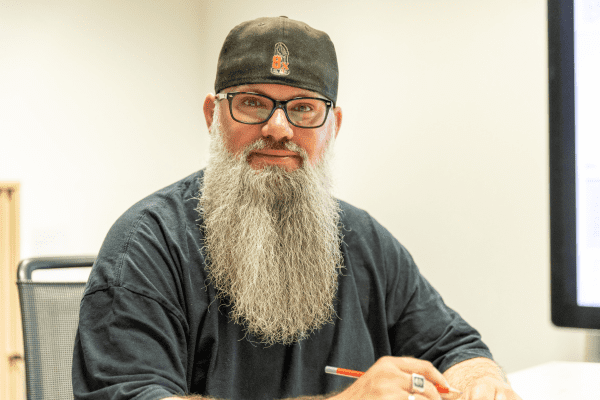
Patricius Watola is the publisher of Grant Magazine and runs an advertising and design agency in Orlando.
Patricius, what drew you to the US? What’s the connection?
Honestly, I don't have any direct personal connection to the US. I don't have that typical story of an uncle in Dallas or a great aunt in Miami, and I’ve never had an extended stay there either. Growing up, I would’ve loved to do a student exchange, but financially, that just wasn’t in the cards for my family.
Was the enthusiasm for the United States always there? How did it come about?
Actually, the enthusiasm wasn’t always there. In 1987, we moved from the Upper Silesian part of Poland to West Germany. As was common at the time, we spent almost a year living in a resettlers’ hostel in Giessen, central Hesse.
Up until 2007, Giessen was home to the central distribution center for the US Armed Forces in Europe, and part of the US troops' properties bordered our accommodation.
In the '80s, around 12,000 Americans were stationed in Giessen, so they were everywhere. You’d see the big American cars, the cool clothes like baseball caps and jerseys, and of course, the friendly people – both around the barracks and in the surrounding civilian housing. It was a constant presence that left an impression.
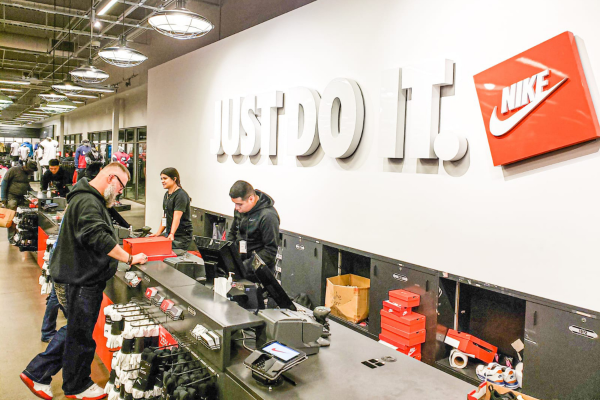
Patricius has been adapting the US clothing style since the 1980s.
You’d see the same things in all the TV shows and movies from the '80s and '90s. There wasn’t a single American series aired in Germany that I didn’t watch. That’s how my fascination with the US really started, and it’s been strong ever since 1987.
Later on, this passion only grew stronger when I worked for an American logistics company for 12 years. That’s when I really started thinking about what it would be like to live in the US.
But, of course, life doesn’t always follow a script. My partner and I started a family, we both had good jobs, and the idea of immigrating to the US took a backseat. I even almost forgot about it for a while. But thanks to social media and the internet, the idea came back to me.
Even so, I didn’t seriously pursue it for a long time. That is, until 2019, when a potential client, Stefan from San Diego, reached out to me on Instagram. He contacted me about a graphic project I had done for a product by Prof. Luigi Colani. Stefan had heard I’d never been to the US and invited me to visit him in San Diego, California.

A customer request turned into a friendship: Stefan invited Patricius to San Diego.
Of course, I didn’t need to be asked twice, so I booked a flight to San Diego. During a day trip to Los Angeles, we stopped by a small boutique in Venice that sold handmade, really cool silver jewelry. The shop assistant was a model from Norway, and after hearing how much I was enjoying the US, she said, 'You have to move here!'
At that moment, another customer who had overheard our conversation came up to me and asked three simple questions: “Do you like it here?” I said, “Yes!” “Would you like to live in the US?” Again, I had to answer, “Yes!” Then he hit me with, “What’s stopping you?” And I said, “Nothing”.
Nothing? I was speechless—something that doesn’t happen often, I can tell you that!
Even today, I think back on that week in sunny San Diego. That trip had a profound impact on me. The friendly people, the openness, how everyone just strikes up a conversation with you, the laid-back vibe. It’s all about living and letting live.
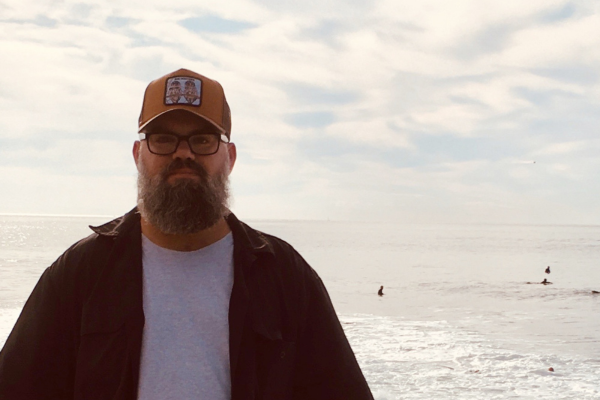
Standing on the beach in La Jolla, it hit Patricius: “I only have one life. Thanks for showing me the way, Stefan!”
One evening, we were at the beach in La Jolla, watching the sunset. The last surfers were catching their final waves before heading in. It felt like a scene from a movie. Stefan turned to me and said, “Isn’t this incredible?” And in my usual, practical way, I replied, “Yeah, sure it’s incredible. But living here doesn’t come cheap.”
That’s when Stefan said something that changed everything: “You’re right. But always remember—you only have one life. You should live it in the place that makes you happiest. You’ll have to work hard no matter where you are, whether here or in Germany.”
That was the turning point. From that day on, I started seriously thinking about what it means to immigrate, live, and work in the US. It didn’t take long for my family and I to realize that we wanted to make the move. Since then, the plan to go to the USA has been front and center in our lives.
Stefan, who was initially just a potential client, became a friend and business partner. He was the one who showed me the way. But it’s up to me to walk that path.
In 2023, you actually went ahead and founded a company in Florida! Tell us about Tryde Design Inc.—what does your company do, and who are your clients?
Tryde is a classic advertising and design agency based in Orlando. I specialize in creating logos, designing websites, and producing print materials like flyers and brochures. I also revamp existing logos, making them more modern, more appealing, and timeless.
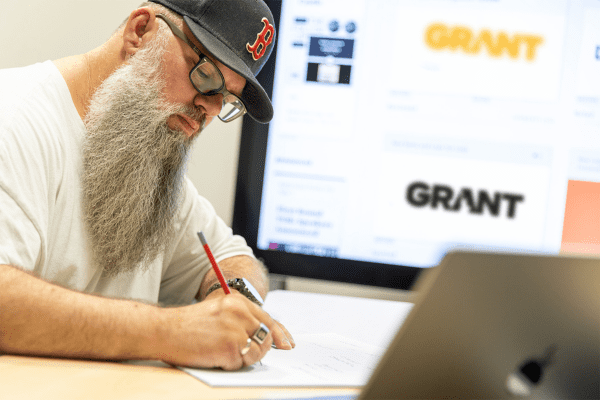
Patricius is working hard to make his dream a reality. Luckily, his family stands behind him 100%.
I also develop names for products and companies, create design concepts, build brand identities, and design product packaging. In short, I handle everything a business needs for its public image. Essentially, I design anything that needs to look professional and visually appealing—what people see first, both inside and outside a company.
My clients include small to mid-sized businesses from a variety of industries all around the world: the US, Germany, Switzerland, the UAE, Taiwan, Poland—just to name a few.
Unlike many other agencies, at Tryde, every client gets the same level of attention. Whether it's a craftsman, a small burger shop with two employees, or a mid-sized company with 250 staff, I make sure to maximize what’s possible within their budget. My clients value that approach, as well as my fast and efficient work and the honest, transparent communication throughout the entire process.
How is it to start a company in the US? Do you have any tips you can share with new entrepreneurs?
Starting a business in the USA is quite straightforward—if you know the process. That’s why I hired a professional consultant to handle the incorporation of my company, a corporation (Inc.). And I’d absolutely do it the same way again to avoid any mistakes. In my opinion, the US is one of the most entrepreneur-friendly countries in the world. You can establish a corporation with relatively low capital investment, and for non-Americans, Florida is an ideal place for this.
Here are my three tips for new entrepreneurs in the USA:
- Perfect presentation: First impressions matter. It’s crucial that your entire public image is cohesive and professional. This includes a well-chosen company name, a thoughtful corporate design, an appealing website, and business materials that stand out from the competition in terms of quality.
- Uniqueness: Especially when it comes to corporate design, it’s essential to remember that the creative, individual expression of a business cannot be replaced by AI. To truly stand out, a unique and carefully crafted design is key.
- Realistic expectations: Finally, it’s important to accept reality—nobody’s waiting for us, not in Germany, and even less so in the US. Success requires initiative, flexibility, and a willingness to embrace change.
We found out about you through the Grant Magazine you bring out. Can you give us an insight?
Grant Magazine is primarily aimed at readers from Germany, Austria, and Switzerland who are interested in topics like emigrating, living, and working in the US. But it's also for those who have already made the move, or anyone looking to learn more about life in the USA and the expat experience.
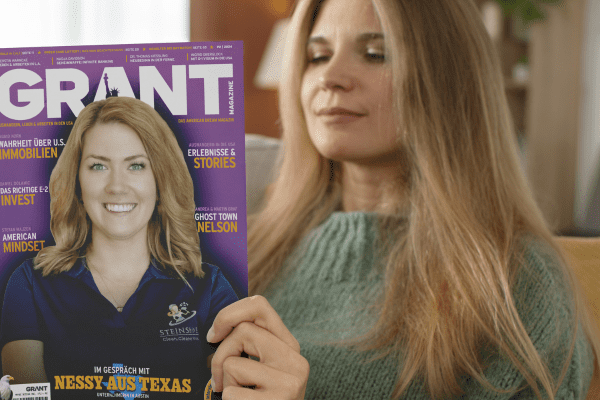
The second issue of Grant Magazine was published on October 1st. Orders can be placed at www.grantmagazine.us.
How did the idea for Grant Magazine come about?
The first thing expats ask each other when they meet in the US is: what do you do, and what visa are you on? It's such an important topic, especially since an extended stay in the US depends on the type of visa you have. But there wasn't a magazine dedicated to that yet.
The original idea was to create an E-2 visa magazine with essential content for people who want to live and work in the USA with the E-2 visa. After the initial conception, however, we took it a step further. Now not only E-2 stories have their place, but also Green Card stories, financial topics, news, lifestyle, and mindset topics, tips on real estate in the USA, and a history corner.
These topics are now a core part of Grant Magazine and are complemented by numerous interviews with people who are already living in the US and thriving there.
Where can our readers buy the Grant Magazine?
The magazine can be ordered through our website, www.grantmagazine.us, either as a print version or a digital edition. Right now, we don’t have a subscription model in place, but who knows what the next six months will bring? I'm currently in the planning phase for the third issue.
How do you manage to produce such a high-quality magazine on top of everything else you're doing?
Thank you for the compliment—I always appreciate hearing that! Honestly, sometimes I don’t even know how I manage it. I’ve pretty much given up on free time and regularly put in 14-hour days, sometimes even longer on weekends. So yeah, my workweek runs from Monday to Sunday.
But because I love what I do and have my family’s full support, I don’t really see my job as “work.” Of course, I do take breaks here and there, but when I do, it feels like pure luxury, and I savor it even more. Sometimes, it’s something as simple as watching the new season of Kleo on Netflix with my family.
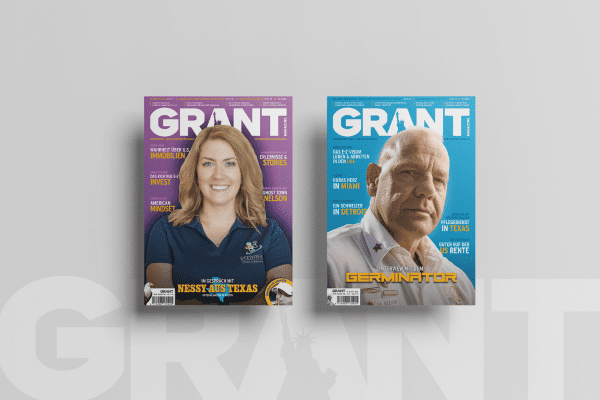
Two issues of Grant magazine have already been published. The third is on its way.
Tell us more about your plans and goals. What's the best way forward for you in Florida?
We are now applying for the E-2 investor visa*. At the same time, we have been taking part in the Green Card Lottery via The American Dream every year since 2020. Like many other participants, we hope that Fortune will be on our side, and we can then apply for a Permanent Residency.
Right now, I’m gathering the necessary investment, as I need to invest locally in the US under the E-2 visa program. That usually means looking for an office, sorting out hardware, servers, software, and other equipment—plus a vehicle. I’m planning to use an older StepVan that’ll be customized in my company’s colors.
We haven’t yet decided exactly where in Florida we’ll move, but it will definitely be somewhere in the Tampa Bay Area. The real work starts once we’re there—acquiring new clients, building and maintaining contacts, and moving forward with every new project. My wife is a huge support, taking care of our kids, which allows me to fully focus on the business. So, in the beginning, my days won’t be getting any shorter.
The goal is to establish my agency quickly in the region and to keep doing what I love with passion, professionalism, and attention to detail. If clients keep coming back and recommending me, I’ll know I’ve reached my goal.
Are you getting any support along the way?
Yes, absolutely. For the E-2 visa, I’m working with a consultant from Bradenton, Florida, and an immigration lawyer in Berlin. The collaboration has been fantastic.
In general, I would always recommend seeking professional help for a venture like this. In the US, there’s a much greater willingness to invest in quality services compared to Germany, which has two big benefits: I minimize the risk of something going wrong, and I can focus on what I do best.
For the Green Card, I would always go through The American Dream. They offer some unbeatable advantages, like reminders for document deadlines and photo uploads, as well as help with creating photos that meet US authorities’ standards. And if you win, they notify you and even offer comprehensive support through the immigration process, which I think is a huge plus!”
In your opinion, what are the biggest challenges when immigrating to the USA?
The biggest challenges, in my opinion, are securing the right visa, finding the right job, and having enough financial resources to support yourself when you first arrive. These are crucial, whether you’re planning to stay temporarily or permanently. Many expats quickly realize that basic costs like rent, car insurance, health insurance, and groceries are higher than what they’re used to in Germany.
Another major factor is whether you’re moving alone, with a partner, or with kids. The challenges and expectations for a single person are completely different from those of a family with children. And it’s essential that your family is fully on board with the “USA project”—especially your partner. If everyone is working together toward the same goal, that’s already a huge challenge checked off the list.
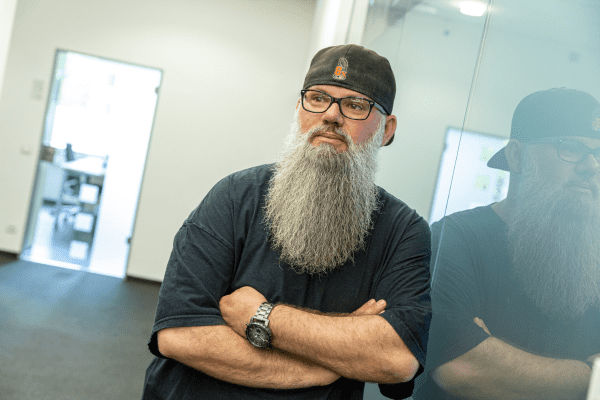
Not a dreamer, but a doer: that’s the impression Patricius leaves with The American Dream editorial team.
What advice would you give to people who are still dreaming of going to the US?
Wake up, stand up, and stop dreaming. No, seriously—dreams are important, and you should never lose sight of them. But dreams also need action to follow. That’s essential. We all have the same 24 hours in a day; the key is what we do with that time. Imagine how incredible it would be to turn your biggest dream into reality. That feeling is unforgettable, and it pushes you to achieve your next goal.
If I had planned to move to the US 25 years ago, I would have done a lot of things differently. I would have furthered my education earlier and saved more money, for example. These are the building blocks that bring you closer to your goal.
For most people, the path to the US is through either the Green Card or the E-2 visa. The latter, of course, requires some planning ahead. The sooner you start preparing for your dream, the sooner it will become a reality.
One thing I personally find important is this: don’t tell anyone around you about your plans. In general, keep your goals and dreams to yourself. As the saying goes, “Stay quiet about your goals and dreams. People can’t destroy what they don’t know.” I wish you all the best on your journey!
Editor's note
We had the privilege of getting an advance look at the latest issue of Grant Magazine, and we highly recommend it! We're crossing our fingers for Patricius in the Green Card Lottery and wishing him swift success in securing his E-2 visa.
*The E-2 visa, also known as the Treaty Investor Visa or Investor Visa, is a classic work visa for the USA. Any company that wants to invest or has invested considerable capital in the US economy can send employees to the USA on an E-2 visa, regardless of their previous business activities in their home country. The US Visa Service of The American Dream will be happy to advise you comprehensively and individually about this work visa and help you with the application process.


 DE
DE EN
EN IT
IT PL
PL TR
TR UA
UA